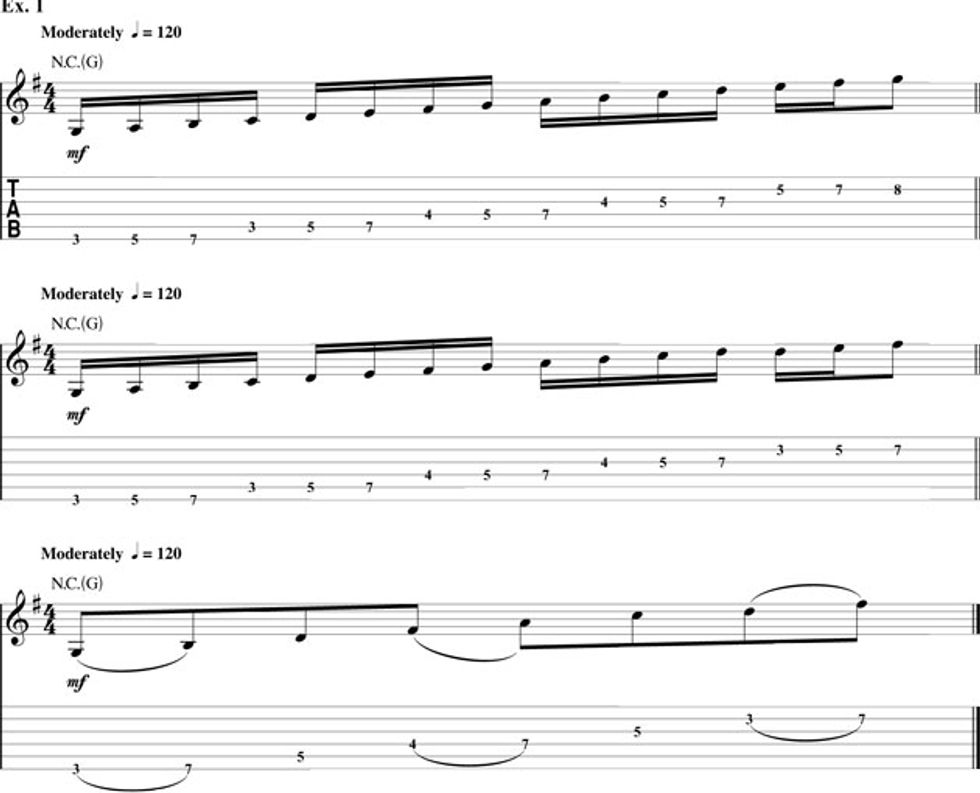Chops: Advanced
Theory: Intermediate
Lesson Overview:
• Improve your hybrid-picking technique.
• Learn how to use the 2-1-2 method with three-note-per-string scales.
• Understand how to improvise through chord changes.
Click here to download a printable PDF of this lesson's notation.
Hybrid picking has always been associated with hot-rod country players like Albert Lee or Danny Gatton. However, it’s such a useful technique that hybrid picking is also becoming popular with fusion, modern rock, and metal guitarists. Brett Garsed and Greg Howe are among those who are known for getting a lovely percussive tone by using their picking-hand fingers to “snap” strings within legato runs.
If you aren’t familiar with hybrid picking, I wouldn’t worry too much, as it’s a case of “just doing it.” Many proficient hybrid pickers started using this technique because it felt natural, and before long it evolved into the tool by which they made music. You can get used to the basic motions by trying some double-string licks where you flatpick the first string and then pluck the adjacent string with the middle finger on the picking hand. You don’t have to be too obsessive with it, just mess around with licks you already know and see if you can get that middle finger involved somehow. It always helps to keep the hybrid finger resting on the string it’s about to play so it’s ready to trigger at the right moment.
In this lesson, we’ll look at a unique way of visualizing three-note-per-string scales to create wide intervallic sounds. Using this visualization, you’ll be ready to conjure up some tasty licks of your own based on hybrid picking.
What does 2-1-2 mean?
I’ve always loved wide intervallic phrases that sound more like arpeggios than just scale runs. I also feel it’s helpful to have various ways of visualizing the fretboard because the more you have, the more sounds you can access.
It’s likely you’re already familiar with three-note-per-string scales. The 2-1-2 method works within this framework by simply taking the first and third notes on one string followed by the middle note on the next string. I don’t wish to take credit for the name, as I am sure lots of players have used this terminology many times before. For the purpose of this lesson, I’ve decided to make the 2-1-2 patterns more concise by visualizing the initial three-note-per-string framework with a unison note between the last note on the 3rd string and the first note on the 2nd string. Take a look at Ex. 1 to see what I mean.
In the first measure we have a three-note-per-string fingering for a G major scale (G–A–B–C–D–E–F#). In the second measure we alter it slightly to repeat the D both on the 3rd and 2nd strings. This keeps the pattern within one position, so to speak, and will help us come up with a concise pattern like we see in the third measure. Try this with multiple positions of the modes of the major scale. You can change it up with position shifts and other kinds of 2-1-2 variations within the framework, but for this lesson we’ll stick to patterns similar to the one in measure three of this example.
The first lick (Ex. 2) shows how we can use the natural layout of the 2-1-2 pattern to create awesome patterns of five picking-hand attacks within two beats. These patterns sound good when played on a 16th-note subdivision because we naturally get a nice syncopation created by the overlapping of the strong notes in each set. I’m using my picking hand’s middle (m) and ring finger (a) to pluck the strings.
Click here for Ex. 2
Ex. 3 shows one of my favorite patterns to do with this hybrid technique. We are going up in groups of four—very reminiscent of the classic pentatonic sequence we all know and love. However, this time it has an arpeggio twist thanks to the 2-1-2 pattern visualization.
Click here for Ex. 3
This lick (Ex. 4) features some position shifts going through the diatonic arpeggios in G major. It starts with a Cmaj7 before moving through Bm7, Am7, and Gmaj7. The phrase ends with a F#m7b5 arpeggio leading into a fun ending. Aim for clean position shifts. The slide down on each string should be nice and clear so you can really hear the tonality changing.
Click here for Ex. 4
This is a fun musical exercise (Ex. 5) to get used to our sequence and also mess around with some seventh chord arpeggio sounds. The sequence follows a simple chord progression: C7–A7–D7–G7. Note on the D7 portion of this lick towards the end of the second measure we have to break away from the hybrid picking. You could either sweep this descending pattern like in Ex. 4 or you can use hammer-ons from nowhere.
Click here for Ex. 5
We’re now going to take a look at using this 2-1-2 technique with the A minor pentatonic scale (A–C–D–E–G) in Ex. 6. The first measure shows us a 3-1-3 pattern, which gives us all the notes of the scale within two octaves. The second measure shows us the relevant 2-1-2 pattern. Using 2-1-2s with minor pentatonics is an amazing, easy, and fun way to get modern wide interval sounds. I love using these in my improvisations.
Click here for Ex. 6
Ex. 7 uses our ascending patterns of four, this time through the A minor pentatonic 2-1-2 pattern. We finish with a classic descending pentatonic phrase using the b5 blue note.
Click here for Ex. 7
Using our ascending fives pattern from Ex. 2 we are now creating a stretchy 2-1-2 pentatonic idea which covers a lot of ground. Watch out for the third group of five, which starts on the 4th string. Reaching for the 15th fret on the 2nd string seems tricky at first, but take it slow and make sure you can slowly move between positions while still remaining relaxed.
Click here for Ex. 8
In Ex. 9 I borrowed ideas from the previous two examples to create an improvised solo. To move between these concepts, I joined each phrase with some tapping and hammer-ons from nowhere. I wholeheartedly encourage you build on the patterns covered in this lesson to create some monster 2-1-2 licks for your own solos and improvisations.












![Rig Rundown: Russian Circles’ Mike Sullivan [2025]](https://www.premierguitar.com/media-library/youtube.jpg?id=62303631&width=1245&height=700&quality=70&coordinates=0%2C0%2C0%2C0)







